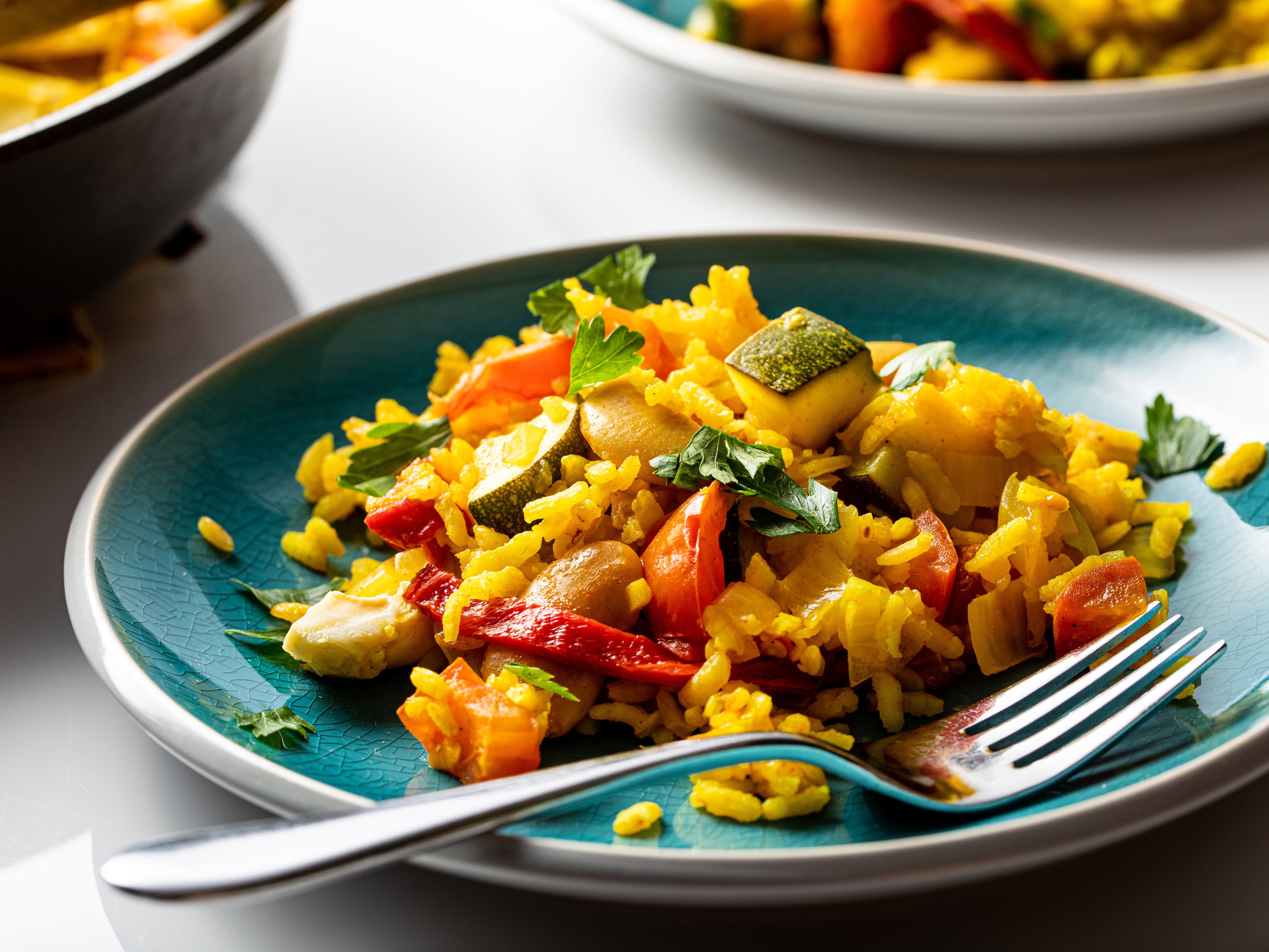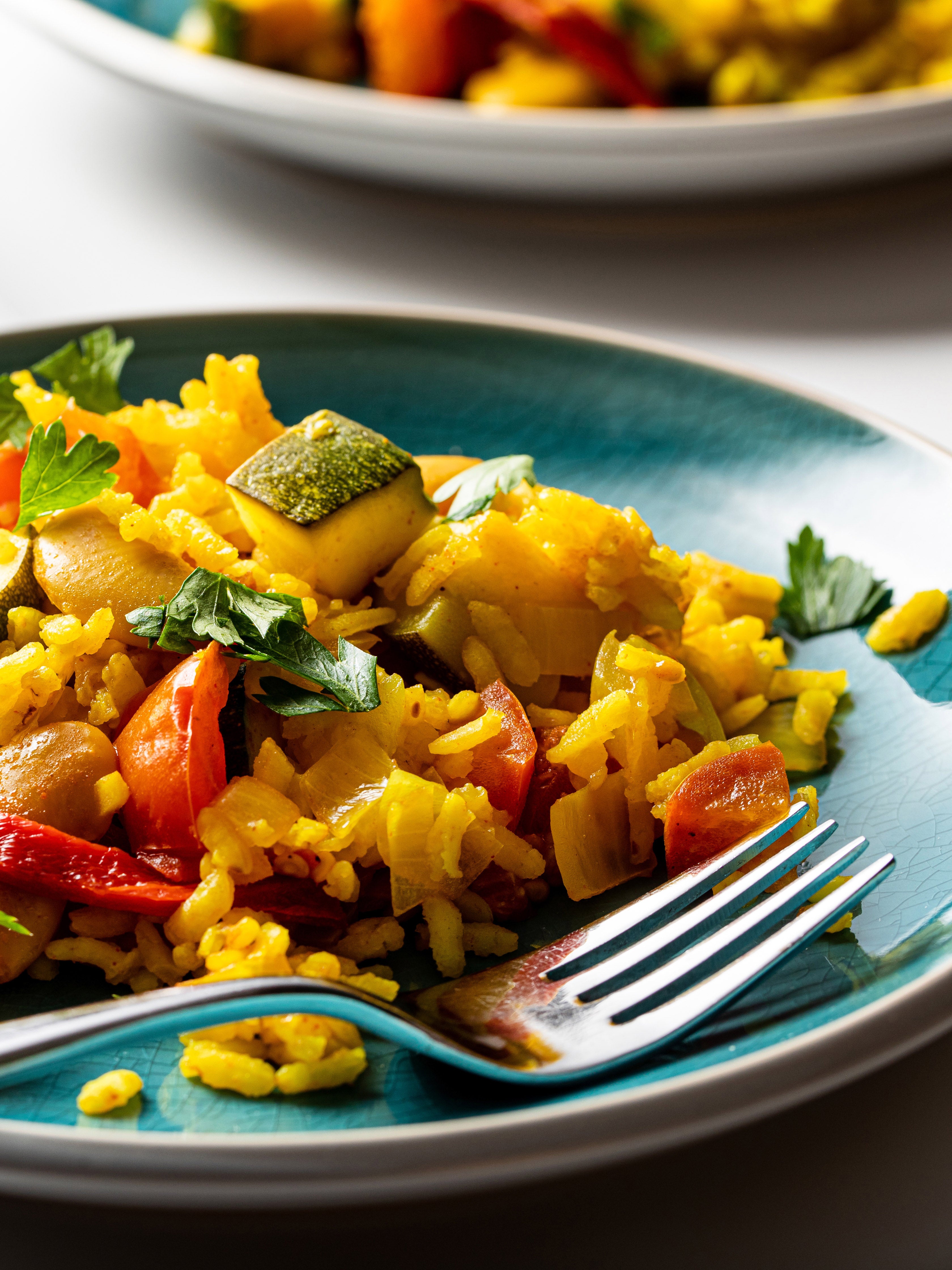A colourful vegetarian paella that’s quick enough for a weeknight
You can get this festive sharing dish on the table in an hour, write Sonja Overhiser and Alex Overhiser

Your support helps us to tell the story
From reproductive rights to climate change to Big Tech, The Independent is on the ground when the story is developing. Whether it's investigating the financials of Elon Musk's pro-Trump PAC or producing our latest documentary, 'The A Word', which shines a light on the American women fighting for reproductive rights, we know how important it is to parse out the facts from the messaging.
At such a critical moment in US history, we need reporters on the ground. Your donation allows us to keep sending journalists to speak to both sides of the story.
The Independent is trusted by Americans across the entire political spectrum. And unlike many other quality news outlets, we choose not to lock Americans out of our reporting and analysis with paywalls. We believe quality journalism should be available to everyone, paid for by those who can afford it.
Your support makes all the difference.Some of the most gourmet and plant-powered dishes feature… wait for it… rice. OK, we know rice doesn’t have the allure of steak or scallops for many people. But believe it or not, humble rice transforms into some seriously sexy dishes.
We’re not talking about just any old rice. We’re featuring arborio rice, an oval-shaped short-grain rice with a pearly white exterior. It’s traditional in Italian risottos, and you can also use it to cook Spanish paella. The dishes are polar opposites in cooking method, and both are absolutely divine.
Paella is a traditional Spanish dish: it’s showy, versatile and feels like a celebration every time. It’s served right in the pan with a vibrant array of veggies, meat and seafood. While it’s often made with short-grained bomba rice, arborio rice is easier to find and holds up well in paella, too.
A good paella maker knows the mantra, “do not stir”. Do not even think about stirring your paella, or you’ll end up with a gummy mess. Rather, set it and forget it: the broth cooks slowly through the rice, leaving a tender, saffron-scented delight behind. When making one-pot rice dishes such as paella, keep the following in mind:
- Measure and chop everything ahead of time. The upfront cooking goes quickly, so we like to have everything measured, chopped and ready to go.
- Pay attention to heat. If it’s too high you’ll get crunchy rice; too low and you'll get soggy rice. Pay close attention to the heat levels specified in the recipe and adjust accordingly.
- Centre the pan. Make sure to keep the pan centred over the heat source for evenly cooked rice.
This paella is fit for a safe small-scale dinner party or a weeknight family meal. It uses traditional Spanish methods while employing cooking tools you already have in your kitchen – no paella pan required.
The bright jumble of veggies and yellow rice is a true showstopper. (Want to add seafood? Saute prawns or scallops before you start the paella, then add them to the top with the quartered artichokes and sliced red peppers.)
Serve with a Spanish red or white wine (might we recommend a tempranillo or an albariño?) and a side of manchego cheese and olives.
Artichoke and roasted red pepper paella

Active time: 45 minutes | Total time: 1 hour
Makes: 4 servings
Storage notes: Leftovers can be refrigerated for up to 2 days; gently reheat on the stove top over low heat.
Notes: Lupini beans are large white beans that you’ll find sold in jars in the supermarket aisle with beans, or near specialty products such as olives and jarred roasted red peppers. If you can’t find them, look for canned butter beans, or use any canned white bean.
Saffron is on the pricey end because of its harvesting method: it is the handpicked stamens of crocus flowers. Because you use only a little per recipe, it’s worth investing in a stash. Saffron adds a unique complexity for which there’s no substitute.
Short-grained bomba rice is a more traditional paella rice than arborio; use it if you can find it.
Ingredients:
2 tbsp extra virgin olive oil
220g white arborio rice (see notes)
1 small yellow onion, cut into small dice
3 medium cloves garlic, minced
1 medium tomato, hulled and chopped
1 medium courgette, trimmed and chopped
240g quartered artichoke hearts (from one 400g tin, drained), ½ chopped and ½ left in quarters
2 large roasted red peppers, 1 chopped and 1 thinly sliced (drained, from a jar)
180g cooked lupini beans or butter beans, drained (may substitute any cooked white beans; see notes)
475ml low-sodium vegetable broth
1 tbsp Spanish smoked paprika (pimenton)
1 tsp saffron threads, loosely packed (see notes)
½ tsp ground turmeric
½ tsp fine sea salt or table salt
Parsley leaves, finely chopped, for garnish
Method:
Heat the oil in a large frying pan (or a paella pan, if you have one) until shimmering over medium-high heat. Add the rice and toast, stirring, until the rice starts to turn light brown, about 2 minutes.
Add the onion and garlic, and cook until coated and fragrant, about 1 minute. Stir in the tomato, courgette, chopped artichokes, chopped roasted red pepper and the beans. Cook, stirring constantly, until well combined, about 1 minute.
Add the broth, paprika, saffron, turmeric and salt. Give the mixture a stir, then do not stir again.
Bring to a rapid simmer and cook for 3 minutes, then reduce the heat to medium-low (still no stirring). Artfully arrange the reserved artichoke quarters and thinly sliced roasted red pepper strips on the surface. Make sure the pan is centered on its burner for even cooking.
Continue to cook at a steady bubble until the broth is fully absorbed, 13 to 15 minutes. After 1 full minute with no audible bubbling, turn off the heat (you can cook the paella a little longer to promote a bottom crust, called socarrat; just proceed at your own risk and pull the pan off the heat before the crust blackens).
Cool for 5 minutes before serving, then garnish with the chopped parsley. Serve from the pan.
Nutrition per serving | Calories: 333; total fat: 8g; saturated fat: 1g; cholesterol: 0mg; sodium: 595mg; carbohydrates: 55g; dietary fibre: 6g; sugar: 7g; protein: 10g.
This analysis is an estimate based on available ingredients and this preparation. It should not substitute for a dietitian’s or nutritionist’s advice.
© The Washington Post
Join our commenting forum
Join thought-provoking conversations, follow other Independent readers and see their replies
Comments